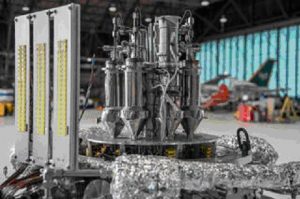From the very beginning of space exploration the possibility of using nuclear reactors to power our spacecraft and inter-planetary probes has both excited and frightened NASA scientists. The amount of energy that could be generated by even a small reactor makes that generated by the big solar arrays on the International Space seem piddling. At the same time however the possibility of something going wrong, of radioactive material falling back to Earth made nuclear reactors seem just to dangerous to attempt.
Only once did the United States put a small nuclear reactor into orbit. The SNAP-10A satellite was designed to provide over 500 watts of power but the failure of a voltage regulator caused the reactor to shut itself down after only 43 days. The image below shows the SNAP-10A with the reactor at the top and the cone shaped radiator for heat removal taking up the bottom 3/4 of the entire satellite. That’s something to remember, in space getting rid of the waste heat is the most important, and hardest part of the design.

Now however NASA is reviving the concept of using nuclear reactors to power larger space probes and maybe one day manned bases on the Moon or Mars. In association with the National Nuclear Security Administration (NNSA) they have designed a series of reactors from 1-kilowatt (kW) to 10-kW in power and have built a 1-kW demonstration unit. The design uses an enriched Uranium 235 core about the size of a roll of paper towels along with passive sodium heat pipes that will conduct the heat to simple-high efficiency Sterling engines. The image below shows the 1-kW demonstration model.

Now it’s worth noting that the average household uses about 3-4kW of power so the 10-kW unit would provide enough power for a small Lunar/Martian outpost. Meanwhile the smaller 1-kW model would power probes to the outer planets where sunlight is so weak that solar panels are useless.
One possibility that would open up with the greater electrical power possible with nuclear reactors is the use of electric propulsion, ion or plasma rocket engines. These propulsion techniques provide enormous amounts of thrust with only small amounts of fuel but require a lot of electrical power. The image below shows a possible design for a nuclear powered, ion rocket inter-planetary probe. The reactor and radiators are on the right hand side and notice how much it resembles the SNAP-10A satellite.

The 1-kW model is now undergoing labouratory testing but in November of this year the reactor is scheduled to begin a year of outdoor testing at the Department of Energy’s (DOE) Nevada National Security Site.
In the long run nuclear powered facilities on the Moon or Mars would provide the power required to covert ice into water, some of which can be separated into oxygen and hydrogen, in other words air to breath and rocket fuel. Eventually nuclear reactors will even power manufacturing facilities to allow our colonies to become independent of supplies.
Of course talk like that is just Science Fiction isn’t it. But then, this blog is called Science and Science Fiction isn’t it.
